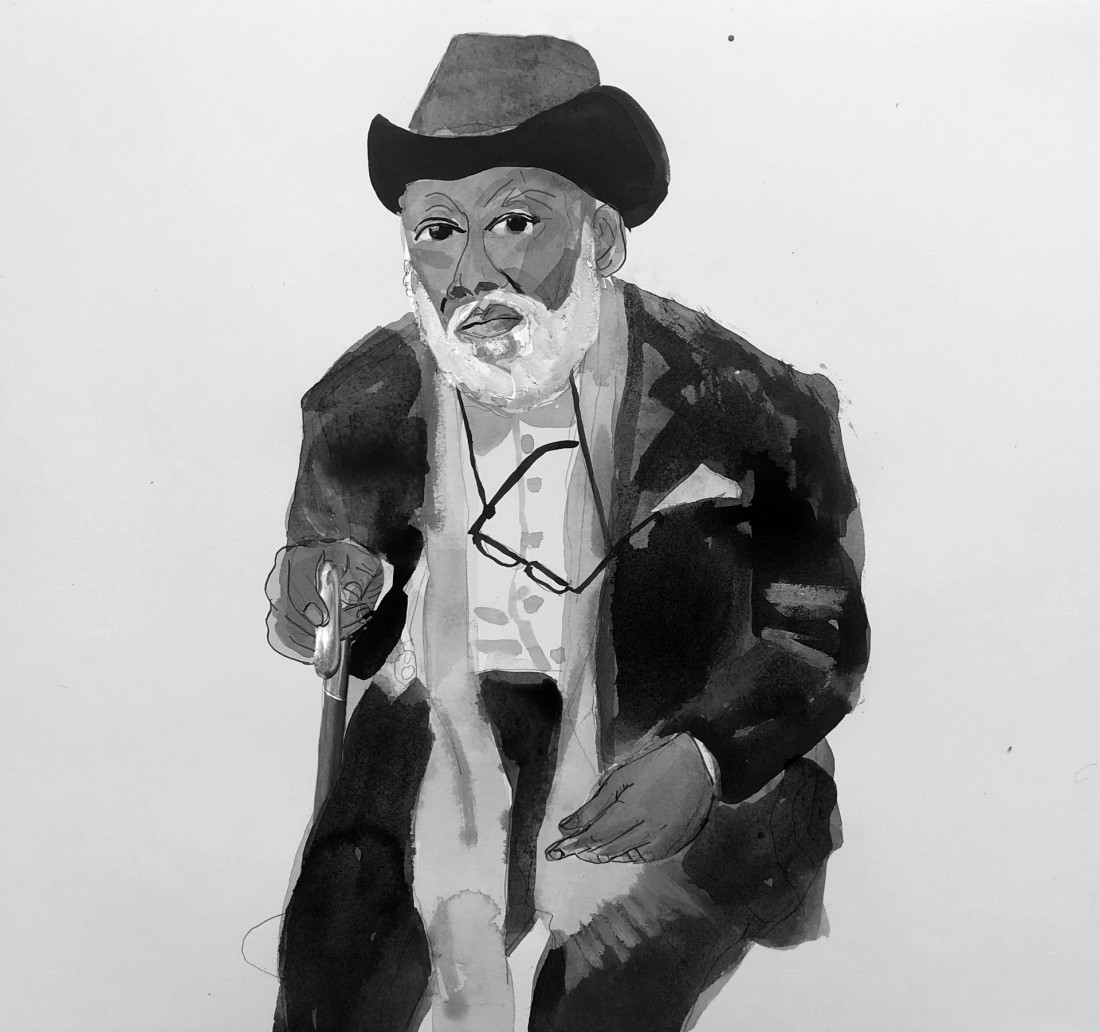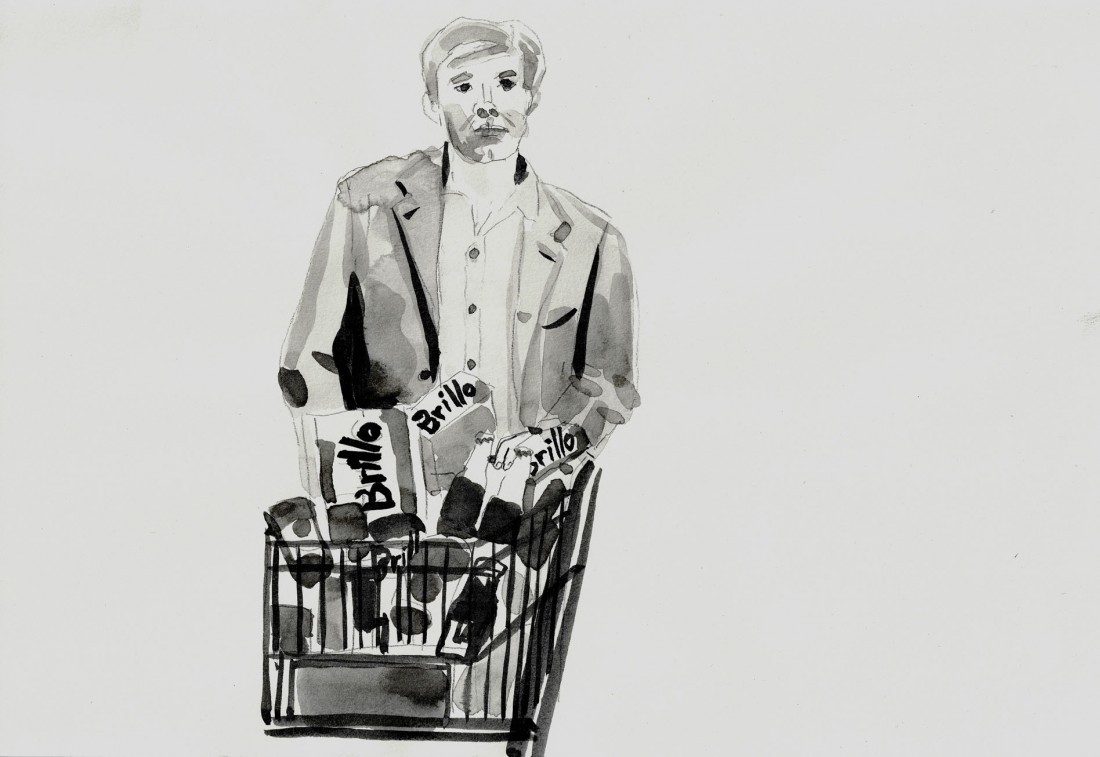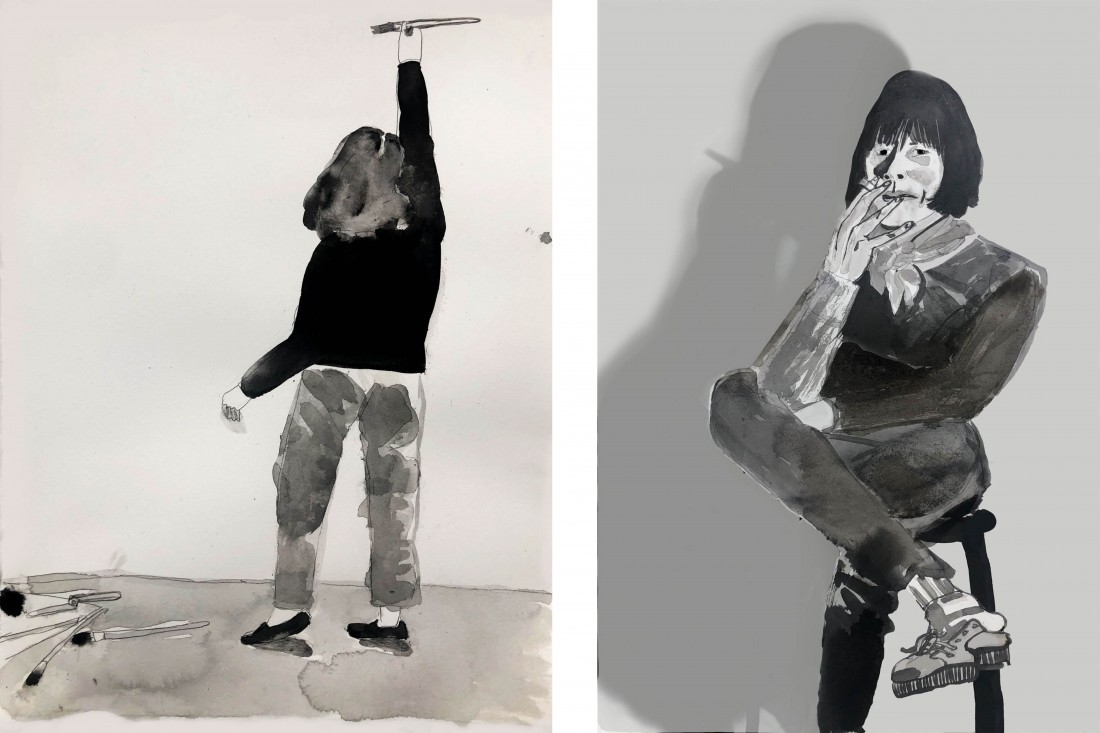The Painter’s Language and the Language of Painting
Amy Sillman
Amy Sillman, the New York-based artist, has been writing reviews, essays and other kinds of criticism for 15 years, but she has only now brought out her first book. Faux Pas: Selected Writings and Drawings is edited and annotated by Charlotte Houette, François Lancien-Guilberteau and Benjamin Thorel, with a foreword by Lynne Tillman, and published by After 8 Books in Paris. In May of this year (and running through October 4), Sillman’s curated exhibition called “The Shape of Shape” was universally regarded as the highlight of MoMA’s expanded reopening, and the most recent show of her own work, called “Twice Removed,” was on exhibition at the Gladstone Gallery in New York from September 30 through November 14, 2020.
In her engaging foreword, Lynne Tillman writes that Sillman “plunders and aggravates language” and that she “detonates words with innovation.” Tillman gets the exact tone and effect of the writing. The book goes some distance in setting in place what we might call a new “cannon” for the way we look at and think about art. Amy Sillman spoke with Robert Enright by phone on October 26, 2020.

Frank Bowling (after a 2019 photograph by Mathilde Agius), 2020, ink on paper, 8.25 x 11 inches. All images courtesy Amy Sillman.
BORDER CROSSINGS: Are the pieces you write only enthusiasms? I wonder if you’ve ever written about an artist whose work you really don’t like.
AMY SILLMAN: The only things I write about are the things I like. There are things that I’m critical about in the book, but they’re not wading into the fray of an argument as much as they are taking a position. But it’s not an antithesis; it’s not an antagonism to a particular artistic position. There are places where I’m holding an opinion staunchly and not liking something and liking something else better. I guess I would say I’m literally fleshing out areas of concern that I feel are underexposed as arguments.
In your review of Carroll Dunham’s book, you say, “His thinking is clearly structured by binaries.” Do you have a sense of what your thinking is structured by?
I think it’s the same, but I am trying to find my way to a third shore. My work is structured by tertiaries. I’ve written things only when I feel there’s an area that hasn’t really been talked about that clearly. For example, I feel like there’s a paucity of writing about the process of making art improvisationally. I have an overall sense that what I’m always trying to write about is this agonistic, uncomfortable, awkward, blind spot, where you’re between doing things and making things and thinking about things. Those are the three shores. When you’re in the process of making art, when you’re in the process of making art decisions, you’re doing something that has an inner structure or an inner rhetoric and something holds together your decisions from moment to moment. It’s not about planning for an act. Working on the spot from the gut is this strange thing where you kind of know what you’re doing and you kind of don’t. I’m basically writing about improvisation after improvisation and I’m writing about decisions that artists make instinctually. And yet they’re guided by analysis and historical observation and knowledge and wisdom, and by experience that’s built up in their minds and in their hands and in their bodies and in their moves. So I’m writing about the mind/body split, but I’m writing about it from inside the split, where there’s actually a terrain. I’m trying to explain what’s going on in your mind between doing things and thinking about things.
When I asked you about Carroll Dunham’s binaries and you characterize your work as being structured by tertiaries, the philosopher who comes to mind is Hegel. Do you come at writing in the way you come at your own work and you find a resolution inside a binary structure?
I don’t think I arrive at a resolution. First of all, there is no resolution; all the process leads to the next process, which is undermined immediately as soon as it’s ebbed back into the ocean. The thing keeps coming around. You can hope for a spiral, at best, but sometimes you don’t even get up to the next level. But, to go back to the important question you’re asking about whether making art and writing are the same process, I think they are the same process, but writ differently when you’re working with language, because you’re working within a framework that to a certain extent is commonly agreed upon. At least there’s some ground on which you can build. When you’re working with abstraction or painting, the praxis of making, you can make weird zigzags and crazy moves that don’t quite follow an expected or pre-set order. Improv is freestyling. Or it could be a code that allows you to disguise your thoughts. If you don’t want to talk about your mom, or want to say something mean about her, you don’t have to paint your mom, you can paint some shapes that stand in for her.
And you say in the book that language is like realism and painting is really abstraction.
Yes. But I don’t think abstraction is just about the presence or the lack of images. I think abstraction is a way to be, or a way to move. So it’s not just that there’s no picture of your mom; abstraction is based on a visual logic, not on linguistic principles. I think there is at its core a real difference between visual phenomena and language, and there are certainly long histories of philosophy that have to do with arguing whether everything boils down to language or whether it doesn’t. I think it doesn’t boil down to language. Language is an amazing framework and I love it more than almost anything else on earth, but there’s something extrinsic to it. What I love about language is that it is invisible. It’s this invisible mesh that we live in. I think it’s like air.
There is a truism that all criticism is a species of autobiography, and occasionally when I read what you say about other artists, I sense I’m also reading what you would say about your own practice.
It’s possible for me to write only about stuff that I know through experience. So it’s about understanding some moves and some problems and some struggles that artists are going through; that isn’t the thing that usually gets written about. I’m just trying to talk about what’s going on in an area that hasn’t been fully fleshed out. I’m writing about the area where thinking is not seen but where I know it’s there, I understand it.

Andy Warhol (after a photograph by Bob Adelman), 2019, ink on paper, 7.625 x 11 inches.
You said you barely knew anything about shape, so you write about it. Do you use writing as a way of learning things you didn’t know before you began to write?
I’m learning when I do the research for writing. But I wouldn’t call what I do “criticism”; I would call it “observation.” I don’t think I am a critic because I’m not judging anyone. All I’m doing is exploring the thing; it’s not about the results, it’s about the process. My writing is a process about process. So it’s not a judgment call; it’s actually a parallel form of making.
When I was thinking about other artists who have been critics, I went to Donald Judd. He reclaims the power of the artist to be self-articulating. You don’t seem to be interested in using or applying power. It seems to me that you don’t use writing; you’re observing as a way of using or applying power. It’s not a contested arena in the way it was for Judd.
Exactly. I love Judd’s writings, but that’s not what I’m doing. I’m just trying to flesh something out, and what I’m trying to flesh out is this crazy area of making that doesn’t have words attached to it and that people don’t literally or physically see. That’s the thing I’m thinking about: how you can map thinking onto something that is a blank zone. Nobody knows what they’re doing in there, including the artist.
You talk about artists taking the power of language into their own hands “with love and antagonism.” I love that combination because it implies carefulness as well as a certain resistance. Are there times when you have an antagonistic relationship to writing?
Not to writing. I love writing. I have a lot of antagonism when I’m making paintings because painting is frustrating. I have resistance to how paintings look when they’re going wrong in my studio. There’s a lot of push and pull and struggle going on. I think painting is like wrestling. In comparison, writing is total joy. There is this beautiful set of words at your disposal, like precision tools. The word shines a light exactly in the place you want to shine it. It’s just perfect for that moment in the essay or in the text. That precision doesn’t always happen with painting. There’s so much writhing around, you don’t know what you’re doing most of the time and there are no guidelines. Also, you can’t edit and come back to the original place. There’s no going backwards with painting, in the way there is with drafts of writing.
Your review of Carroll Dunham’s book is wonderful and one of the reasons for that is the way you open the piece. When you say right out of the gate that “Carroll Dunham is weird,” you get the reader’s attention. But then to secure that attention, you add, “and perverse.” That strikes me as an especially cagey opening gambit. Were you conscious of the trap you were setting for the reader in writing it? Or did you just want to say that Carroll Dunham is weird and perverse?
I was charged with the task of writing a review of his book and so I read it very carefully. And he used the word “weird” all the time in his essays, so I realized that, like me and probably most people, he notices the things that he also tends toward. What I wanted to say was, “Carroll Dunham is a weirdo and I mean it in the best way,” but my editor didn’t want me to add the second part. I could start the essay by saying, “Weird is the most-used adjective in the new book of Carroll Dunham’s essays,” but I wanted to point it directly to him, not adjectives. I think a lot of times I anthropomorphize things, people and language. Lynne Tillman pointed out that she thought it was funny that I started the essay on the abstract expressionists by saying, “I feel kind of bad for Ab Ex.” I didn’t think of this before, but I would say that if I looked at the way I start out essays, a lot of times it is through the act of pointing at something to make it a character that I then set out to describe.
You often seem to find strange ways into your subject. So you are attracted to the sculptor John Chamberlain because he doesn’t fit the aesthetics of Dia, where you propose to talk about him. So that gives you an inroad. And you’re interested in the screwed-up psychology of Delacroix and his “death drive.” Do you consciously look for surprising things to say about an artist?
I think that’s a more precise, granular description of how I’m looking for a character to describe. A lot of times I’ll be attracted to a subject because it’s a failure or awkward or uncomfortable, or it’s a mess, or it doesn’t reveal itself well. Those are all the things that make the character interesting to me. Accidents and mistakes and errors and risking failure are what I like about art, and those are all things that I believe in and that I’m trying to flirt with or get near. If something’s weird, I’ll like it. If I feel sorry for it, I’ll like it. If something’s not what it’s supposed to be, I’ll like it. It’s being interested in the underdog. And those are not winners. I’m not interested in patting a winner on the back.
Well, you’re from Chicago so you’re already an outsider. To use that wonderful description from Philip Guston, you come at the world as an “edge-of-towner.”
Yes. I’m from the Midwest, and in the Midwest, you say what you mean and you mean what you say. I am not an ironic writer. I’m trying to write about off-key stuff, malfunction, misunderstanding, conflicts, things that don’t follow.
So it’s not surprising that one of your most popular pieces of writing, “Shit Happens, Notes on Awkwardness,” becomes almost a manifesto. It’s a description of what interests you.
Totally. That’s the piece where I try really hard to specifically say, “What the fuck is going on when you’re trying to make art?” I work emotionally and I make things with a certain amount of self-pity, loneliness and awkwardness. I’m spurred to make things out of negative feelings. It’s not out of my joy of life. I think sorrow and trouble and melancholy—the off-emotions—are where my moody art-making practice springs from. I think that’s pretty normal. So I’m not interested in being a critic and I’m also not interested in resolving a problem. I mean, that’s not my purpose. It’s not like, “How should we fix it?”

Left: Joan Mitchell in her studio (after a 1957 photograph by Rudy Burckhardt), 2020, ink on paper, 14 x 11 inches. Right: Maria Lassnig, 2020, ink on paper, digitally altered, 17 x 11 inches.
But we are living in a period where notions of inclusion are much more evident than they have been before. There seems to have been a shift in the way that everyone is approaching the question of diversity, who’s in, who’s out, and any canonical notion of what constitutes art history.
I would say that what’s really important to me within that political call is to speak about diverse kinds of form, different intentions, or values, in making stuff, and the ways that both content and form can be enlightening and emancipatory within that same discourse. That’s the reason I am still committed to the idea of exactly this project that we’ve been talking about for over an hour now, of trying to uncover things that are often concealed. The reason I want to think about form and to illuminate the decisions that people make in their studios and in general as individuals, as bodies, as embodied people, is because I feel form is also in that territory of the unspoken-about.
Among the most moving pieces in your book is the “Letter to Maria Lassnig.” She’s one of the “undocumenteds” who fall out of memory. You have that beautiful line to her where you write, “you seem to have passed through New York like a shadow.” What you’re addressing there is not so much a political dimension as a personal one. So the process of writing about art is also an emotional recovery through memory?
Totally. The whole purpose of art, for me, emotionally, is about recuperation. If there is a Hegelian structure in the way I think about things, the dialectic is not a resolution, but it is a repair. It’s the work of recuperating a schism or a split that’s painful in your brain, in your soul. Patching things and making and mending and building and knitting and all that bridge-building stuff are all part of the process of going through these really painful, interesting struggles in your studio. I think it’s all about recuperating.
Which is essentially a kind of ethics?
Totally. It’s not activism in the streets, but it is ethics, and I’d say political, for a society of people to connect, to imagine, and to speak, to define how they want to survive.❚

